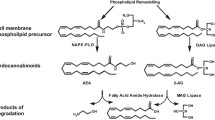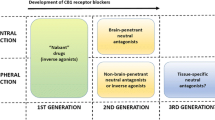Abstract
The endocannabinoid system (ECS) plays a physiologic role in modulating energy balance, feeding behavior, lipoprotein metabolism, insulin sensitivity, and glucose homeostasis, which when dysregulated can all contribute to cardiometabolic risk. Evidence has suggested that the ECS is overactive in human obesity and in animal models of genetic and diet-induced obesity. ECS stimulation centrally and peripherally drives metabolic processes that mimic the metabolic syndrome. These findings have led to the development of potential novel therapeutic targets, including the drug rimonabant, a selective CB1 receptor antagonist, which has been shown to promote weight loss, reduce inflammation, improve dyslipidemia, and improve glucose homeostasis.
Similar content being viewed by others
References and Recommended Reading
Matias I, Gonthier MP, Orlando P, et al.: Regulation, function and dysregulation of endocannabinoids in models of adipose and beta-pancreatic cells and in obesity and hyperglycemia. J Clin Endocrinol Metab 2006, 91:3171–3180.
Gaoni Y, Mechoulam R: Isolation, structure and partial synthesis of an active constituent of hashish. J Am Chem Soc 1964, 86:1646–1647.
Matsuda LA, Lolait SJ, Brownstein MJ, et al.: Structure of a cannabinoid receptor and functional expression of the cloned cDNA. Nature 1990, 346:561–564.
Howlett AC: The cannabinoid receptors. Prostaglandins Other Lipid Mediat 2002, 68:619–631.
Ameri A: The effects of cannabinoids on the brain. Prog Neurobiol 1999, 58:315–318.
Howlett AC, Barth F, Bonner TI, et al.: International Union of Pharmacology. XXVII. Classification of cannabinoids receptors. Pharmacol Rev 2002, 54:161–202.
Okamoto Y, Morishita J, Tsuboi K, et al.: Molecular characterization of a phospholipase D generating anandamide and its congeners. J Biol Chem 2004, 279:5298–5305.
Piomelli D: The molecular logic of endocannabinoid signaling. Nat Rev Neurosci 2003, 4:873–884.
Engeli S, Bohnke J, Feldpausch M, et al.: Activation of the peripheral endocannabinoid system in human obesity. Diabetes 2005, 54:2838–2843.
Kirkham TC, Williams CM, Fezza F, et al.: Endocannabinoid levels in rat limbic forebrain and hypothalamus in relation to fasting, feeding and satiation: stimulation of eating by 2-arachidonoyl glycerol. Br J Pharmacol 2002, 136:550–557.
Sharkey KA, Pittman QJ: Central and peripheral signaling mechanisms involved in endocannabinoid regulation of feeding: a perspective on the munchies. Sci STKE 2005, pe15.
Di Marzo V, Matias I: Endocannabinoid control of food intake and energy balance. Nat Neurosci 2005, 8:585–589.
Di Marzo V, Goparaju SK, Wang L, et al.: Leptin-regulated endocannabinoids are involved in maintaining food intake. Nature 2001, 410:822–825.
Hanus L, Avraham Y, Ben-Shushan D, et al.: Short term fasting and prolonged semistarvation have opposite effects on 2-AG levels in the mouse brain. Brain Res 2003, 983:144–151.
Hao S, Avaraham Y, Mechoulam R, et al.: Low dose anandamide affects food intake, cognitive function, neurotransmitter and corticosterone levels in diet-restricted mice. Eur J Pharmacol 2000, 392:147–156.
Matias I, Di Marzo V: Endocannabinoids and the control of energy balance. Trends Endocrinol Metab 2006, 18:27–37.
Ravinet Trillou C, Delgorge C, et al.: CB1 cannabinoid receptor knockout in mice leads to leanness, resistance to diet-induced obesity and enhanced leptin sensitivity. Int J Obes Relat Metab Disord 2004, 28:640–648.
Bensaid M, Gary-Bobo M, Esclangon A, et al.: The cannabinoid CB1 receptor antagonist SR141716 increases Acrp30 mRNA expression in adipose tissue of obese fa/fa rats and in cultured adipocyte cells. Mol Pharmacol 2003, 63:908–914.
Cota D, Marsiacano G, Tschop M, et al.: The endogenous cannabinoid system affects energy balance via central orexigenic drive and peripheral lipogenesis. J Clin Invest 2003, 112:423–431.
Gary-Bobo M, Elachouri G, Scatton B, et al.: The cannabinoid CB1 receptor antagonist rimonabant (SR141716) inhibits cell proliferation and increases markers of adipocyte maturation in cultured mouse 3T3 F442A preadipocytes. Mol Pharmacol 2006, 69:471–478.
Bluher M, Engeli S, Kloting N, et al.: Dysregulation of the peripheral and adipose tissue endocannabinoid system in human abdominal obesity. Diabetes 2006, 55:3053–3060.
Engeli S, Fledpausch M, Gorzelniak K, et al.: Association between adiponectin and mediators of inflammation in obese women. Diabetes 2003, 52:942–947.
Woods SC: Role for the endocannabinoid system in regulating cardiovascular and metabolic risk factors. Am J Med 2007, 120:S19–S25.
Osei-Hyiaman D, DePetrillo M, Pacher P, et al.: Endocannabinoid activation at hepatic CB1 receptors stimulates fatty acid synthesis and contributes to diet-induced obesity. J Clin Invest 2005, 115:1298–1305.
Medina J, Fernández-Salazar L, García-Buey L, Moreno-Otero R: Approach to the pathogenesis and treatment of nonalcoholic steatohepatitis. Diabetes Care 2004, 27:2057–2066.
Teixeira-Clerc F, Julien B, Grenard P, et al.: CB1 cannabinoid receptor antagonism: a new strategy for the treatment of liver fibrosis. Nat Med 2006, 12:671–676.
Liu YL, Connoley IP, Wilson CA, Stock MJ: Effects of CB1 receptor antagonist SR141716 on oxygen consumption and soleus muscle glucose uptake in lep(ob)/lep(ob) mice. Int J Obes Relat Metab Disord 2005, 29:183–187.
Pagotto U, Marsicano G, Cota D, et al.: The emerging role of the endocannabinoid system in endocrine regulation and energy balance. Endocr Rev 2006, 27:73–100.
Juan-Pico P, Fuentes E, Bermudez-Silva FJ, et al.: Cannabinoid receptors regulate Ca(2+) signals and insulin secretion in pancreatic beta cell. Cell Calcium 2005, 39:155–162.
Bermudez-Siva FJ, Serrano A, Diaz-Molina F, et al.: Activation of cannabinoid CB1 receptors induces glucose intolerance in rats. Eur J Pharmacol 2006, 531:282–284.
Bermudez-Silva FJ, Sanchez-Vera I, Suarez J, et al.: Role of cannabinoid CB2 receptors in glucose homeostasis in rats. Eur J Pharmacol 2007, 565:207–211.
Gomez R, Navarro M, Ferrer B, et al.: A peripheral mechanism for CB1 cannabinoid receptor-dependent modulation of feeding. J Neurosci 2002, 22:9612–9617.
Coutts AA, Izzo AA: The gastrointestinal pharmacology of cannabinoids: an update. Curr Opin Pharmacol 2004, 4:572–579.
Grundy SM, Cleeman JI, Daniels SR, et al.: Diagnosis and management of the metabolic syndrome. An American Heart Association/National Heat, Lung and Blood Institute Scientific Statement. Circulation 2005, 112:2735–2752.
American Heart Association: Heart disease and stroke statistics-2007 Update-At-a-Glance. Available at http://www.americanheart.org/downloadable/heart/1166711577754HS_StatsInsideText.pdf. Accessed October 25, 2007.
National diabetes information clearinghouse: National diabetes statistics. Available at http://diabetes.niddk.nih.gov/dmpubs/statistics/. Accessed August 10, 2007.
Ford ES, Giles WH, Mokdad AH: Increasing prevalence of the metabolic syndrome among US adults. Diabetes Care 2004, 27:2444–2449.
Harrold JA, Elliott JC, King PJ, et al.: Down-regulation of cannabinoid-1 (CB1) receptors in specific extrahypothalamic regions of rats with dietary obesity: a role for endogenous cannabinoids in driving appetite for palatable food? Brain Res 2002, 952:232–238.
Maccarrone M, Fride E, Bisogno T, et al.: Up-regulation of the endocannabinoid system in the uterus of leptin knockout (ob/ob) mice and implications for fertility. Mol Hum Reprod 2005, 11:21–28.
Cote M, Matias I, Lemieux I, et al.: Circulating endocannabinoid levels, abdominal adiposity and related cardiometabolic risk factors. Int J Obes 2007, 31:692–699.
Rinaldi-Carmona M, Barth F, Heaulme M, et al.: SR141716A, a potent and selective antagonist of the brain cannabinoid receptor. FEBS Lett 1994, 350:240–244.
Ravinet-Trillou C, Arnone M, Delgorge C, et al.: Antiobesity effect of SR141716, a CB1 receptor antagonist, in diet induced obese mice. Am J Physiol Regul Integr Comp Physiol 2003, 284:R345–R353.
Jbilo O, Ravinet-Trillou C, Arnone M, et al.: The CB1 receptor antagonist rimonabant reverses the diet induced obesity phenotype through the regulation of lipolysis and energy balance. FASEB J 2005, 19:1567–1569.
Despres JP, Golay A, Sjostrom L: Effects of rimonabant on metabolic risk factors in overweight patients with dyslipidemia. N Engl J Med 2005, 353:2121–2134.
Pi-Sunyer FX, Aronne LJ, Heshmati HM, et al.: Effect of rimonabant, a cannabinoid receptor 1 blocker, on weight and cardiometabolic risk factors in overweight or obese patients: RIO-North America: a randomized controlled trial. JAMA 2006, 295:761–765.
Van Gaal LF, Rissanen AM, Scheen AJ, et al.: Effects of the cannabinoid-1 receptor blocker rimonabant on weight reduction and cardiovascular risk factors in overweight patients: 1-year experience from the RIO-Europe study. Lancet 2005, 365:1389–1397.
Scheen AJ, Finer N, Hollander P, et al.: Efficacy and tolerability of Rimonabant in overweight or obese patients with type 2 diabetes: a randomized controlled study. Lancet 2006, 368:1660–1672.
Iranmanesh A, Rosenstock J, Hollander P: SERENADE: Rimonabant monotherapy for treatment of multiple cardiometabolic risk factors in treatment-naive patients with type 2 diabetes. Diabet Med 2006, 23(suppl 4):230A (637b).
Author information
Authors and Affiliations
Corresponding author
Rights and permissions
About this article
Cite this article
Perkins, J.M., Davis, S.N. Endocannabinoid system overactivity and the metabolic syndrome: Prospects for treatment. Curr Diab Rep 8, 12–19 (2008). https://doi.org/10.1007/s11892-008-0004-3
Published:
Issue Date:
DOI: https://doi.org/10.1007/s11892-008-0004-3




